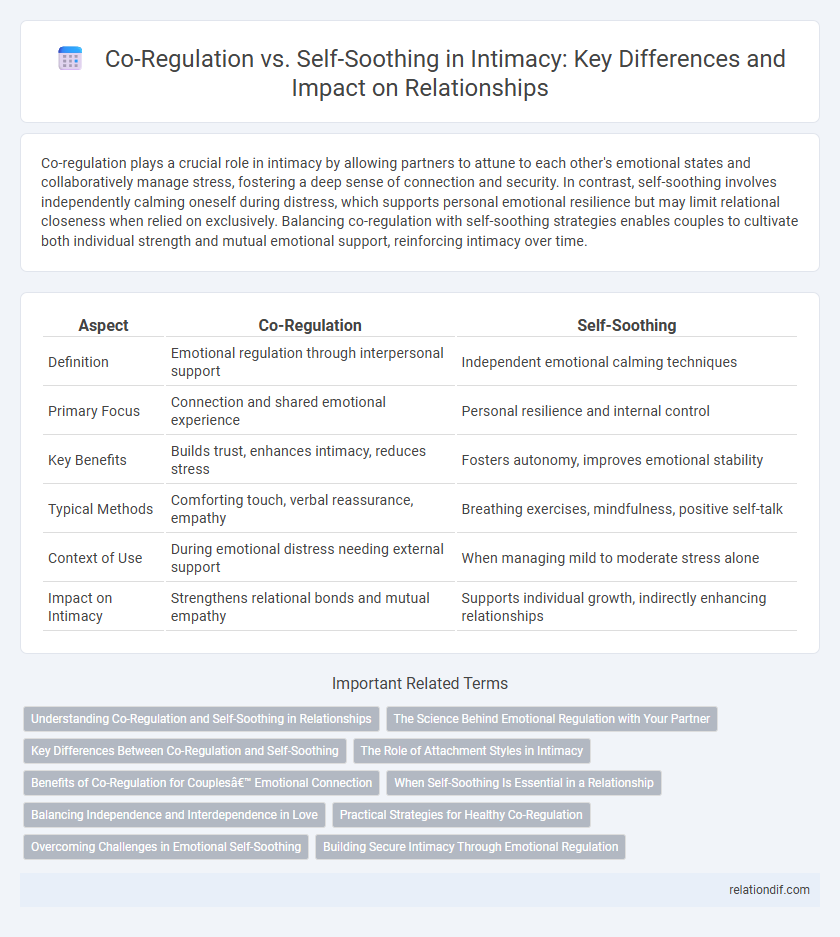Co-regulation plays a crucial role in intimacy by allowing partners to attune to each other's emotional states and collaboratively manage stress, fostering a deep sense of connection and security. In contrast, self-soothing involves independently calming oneself during distress, which supports personal emotional resilience but may limit relational closeness when relied on exclusively. Balancing co-regulation with self-soothing strategies enables couples to cultivate both individual strength and mutual emotional support, reinforcing intimacy over time.
Table of Comparison
| Aspect | Co-Regulation | Self-Soothing |
|---|---|---|
| Definition | Emotional regulation through interpersonal support | Independent emotional calming techniques |
| Primary Focus | Connection and shared emotional experience | Personal resilience and internal control |
| Key Benefits | Builds trust, enhances intimacy, reduces stress | Fosters autonomy, improves emotional stability |
| Typical Methods | Comforting touch, verbal reassurance, empathy | Breathing exercises, mindfulness, positive self-talk |
| Context of Use | During emotional distress needing external support | When managing mild to moderate stress alone |
| Impact on Intimacy | Strengthens relational bonds and mutual empathy | Supports individual growth, indirectly enhancing relationships |
Understanding Co-Regulation and Self-Soothing in Relationships
Co-regulation in relationships involves partners mutually managing emotions, providing support that fosters trust and emotional connection. Self-soothing refers to an individual's ability to regulate their own emotional state independently, promoting personal resilience and emotional stability. Recognizing the balance between co-regulation and self-soothing enhances intimacy by allowing partners to support each other while maintaining individual emotional health.
The Science Behind Emotional Regulation with Your Partner
Emotional regulation in intimate relationships involves both co-regulation and self-soothing processes that help partners manage stress and maintain connection. Neuroscientific studies reveal that co-regulation activates the brain's social bonding pathways, such as the release of oxytocin, enhancing emotional attunement and mutual calming. Effective co-regulation and self-soothing strategies improve relationship satisfaction by stabilizing emotional responses and fostering secure attachment bonds.
Key Differences Between Co-Regulation and Self-Soothing
Co-regulation involves mutual emotional support where both partners actively respond to each other's distress, fostering connection and security. Self-soothing relies on an individual's internal strategies to calm themselves without external assistance, promoting personal resilience and emotional regulation. The key difference lies in co-regulation's interpersonal dynamic versus self-soothing's internal, solitary process.
The Role of Attachment Styles in Intimacy
Attachment styles significantly influence intimacy by shaping how individuals engage in co-regulation versus self-soothing behaviors. Securely attached individuals tend to seek and offer co-regulation, fostering emotional closeness and mutual support in relationships. In contrast, those with anxious or avoidant attachment styles often rely more on self-soothing techniques, which can hinder deep emotional connection and limit intimacy.
Benefits of Co-Regulation for Couples’ Emotional Connection
Co-regulation enhances couples' emotional connection by fostering mutual understanding and empathy, which strengthens relational bonds and promotes emotional security. Sharing stress and calming each other activates the parasympathetic nervous system, reducing anxiety and creating a safe emotional environment. This collaborative process supports emotional resilience and deepens intimacy by encouraging vulnerability and trust between partners.
When Self-Soothing Is Essential in a Relationship
Self-soothing is essential in a relationship when individual emotional regulation supports healthier interactions and reduces dependency on partners for stability. Developing personal coping mechanisms like mindfulness or deep breathing enables partners to manage stress independently, fostering emotional resilience. This balance prevents overwhelm in intimacy dynamics, allowing co-regulation to become a more effective shared process.
Balancing Independence and Interdependence in Love
Balancing independence and interdependence in love involves navigating the dynamic between co-regulation and self-soothing to foster emotional resilience and intimacy. Co-regulation strengthens connection by sharing emotional experiences and mutual support, while self-soothing cultivates individual emotional regulation and autonomy. Harmonizing these processes creates a secure relational environment where partners maintain personal boundaries without sacrificing emotional closeness.
Practical Strategies for Healthy Co-Regulation
Practical strategies for healthy co-regulation in intimacy include active listening and expressing empathy to create a secure emotional environment. Couples benefit from synchronized breathing exercises and mutual grounding techniques that enhance emotional attunement and reduce stress responses. Establishing consistent communication patterns and recognizing each partner's emotional cues foster resilience and deepen relational trust.
Overcoming Challenges in Emotional Self-Soothing
Overcoming challenges in emotional self-soothing requires developing awareness of internal cues and practicing mindfulness techniques to regulate distress independently. Co-regulation, involving responsive support from close relationships, can serve as a transitional tool to build resilience before mastering self-soothing strategies. Integrating both approaches enhances emotional stability and fosters deeper intimacy by balancing autonomy with secure attachment.
Building Secure Intimacy Through Emotional Regulation
Building secure intimacy relies on effective emotional regulation strategies such as co-regulation and self-soothing. Co-regulation involves partners attuning to each other's emotional cues, fostering trust and safety through shared calming techniques that strengthen relational bonds. Self-soothing empowers individuals to manage their emotional states independently, promoting resilience and emotional stability essential for deep, secure connections.
co-regulation vs self-soothing Infographic

 relationdif.com
relationdif.com